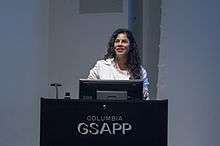Anupama Kundoo
Anupama Kundoo (born in Pune in 1967) is an indian architect.
Anupama Kundoo | |
|---|---|
 Anupama Kundoo in 2016 | |
| Born | 1967 (age 52–53) Pune, India |
| Nationality | Indian |
| Occupation | Architect |
| Years active | 1990–present |
Biography
Anupama Kundoo studied architecture at the Sir J. J. College of Architecture, University of Bombay and received her degree in 1989. She was awarded the Vastu Shilpa Foundation Fellowship in 1996 for her thesis on "Urban Eco-Community: Design and Analysis for Sustainability". She got her doctoral degree from the Technical University of Berlin in 2008.[1][2]
Kundoo established herself as an architect in Auroville in 1990 where she designed and built many buildings with "energy and water efficient infrastructure" adaptations.[3] She worked here from middle of 1990 till 2002.[4]
Kundoo taught at the Technical University, Berlin, and Darmstadt in Hesse during 2005.[5] She worked as Assistant Professor at Parsons The New School for Design, New York[2] until 2011 then moving to Australia as a senior lecturer in the University of Queensland. In 2014, she shifted to Europe and began working at the European School of Architecture and Technology at the Universidad Camilo José Cela in Madrid.[6]
Work
Her approach to building design is based on material research that minimizes environmental effects.[3] Her basic design approach is to use "waste materials, unskilled labour and local communities".[7]
One of the notable buildings built for her own residence is titled the "Wall House", built in a community area of 15 acres (6.1 ha) with a built in space of 100 square metres (1,100 sq ft) constructed at a cost of one million Rupees in 2000,[3] in Auroville for communal living.[8] This house is L-Shaped in plan, has a courtyard in the middle; while it is modern in concept it adopts traditional "vernacular" use of materials such as compressed earth, concrete and steel. The bathroom is set in open-to-sky design, with smooth merging with the interior and external spaces and landscaped in manner which gives it both a modern and a regional appearance.[9] A full sized replica of her Wall House was made by hand and exhibited at the Venice Biennale of Architecture.[4] Net York Times called it as "a gem among rubble".
Another of her theme is "Liberty" which presents a reading place as a free library, a creation built with three types of trees fixed in the centre of a square space. The trees' trunks and branches are made from steel and the leaves made of salvaged books, with the floor made of concrete. This was exhibited at the Placa de Salvador Segui in Barcelona during June–September 2014.[10]
Publications
- Books
- Roger Anger: Research on Beauty/Recherche sur la beauté Architecture 1958–2008, jovis Verlag GmbH, Berlin, 2009
- Papers[11]
- Das Tauziehen zwischen Umweltschutz und Entwicklung, Bauwelt, Bauverlag BV GmbH, Gütersloh, March 2011
- More than cladding, Design Today, Living Media India Ltd, New Delhi, June 2010
- Who decides what’s green, Design Today, Living Media India Ltd, New Delhi, March 2010
- Urban development, Options for urbanisation, Survey of the environment, The Hindu, Chennai, 2008
- Roger Anger: Chief Architect of Auroville, Architecture Time Space & People, Magazine of the Council of Architecture, India, Delhi, May 2008
- Auroville: An Architectural Laboratory, Made in India, AD Architectural Design, John Wiley and Sons Ltd., London, November – December 2007
- Eco-friendly Approach, Architecture + Design, Vol. XXIII, No 2, Media Transasia, Delhi, February 2006
- Sustainability and Globalisation, Indian Architect & Builder, Jasubhai Publications, Mumbai, July 2005
- Devoted to Dance, Ray Meeker´s expression to Protima Bedi´s parting gift, a fired temple at Nrityagram, Inside Outside, Mumbai, October 2000
- Cues from the Past – Local details and traditional elements in a contemporary structure, Indian Architect & Builder, Jasubhai Publications, Mumbai, October 1997
- Comments on Building Blocks, Indian Architect & Builder, Jasubhai Publications, Mumbai, January 1992
Awards
- Top five "globe-spanning " architects featured in "The Architect is Present"
References
- Anger 2009, p. 188.
- "Anupama Kundoo Strauch Visiting Critic". Ithaca, New York: Cornell University. 2014. Retrieved 16 November 2015.
- Tipnis 2012, p. 15.
- Heathcote, Edwin (28 March 2014). "Anupama Kundoo's handmade architecture". The Financial Times Ltd. Retrieved 17 October 2015.
- "Bricks and mortar". Anupama Kundoo. India Today. 10 January 2008. Retrieved 17 October 2015.
- "The Architect is Present': biografía de Anupama Kundoo". Madrid, Spain: Arquitectura Viva. 14 March 2014. Retrieved 16 November 2015.
- Haddad, Rifkind & Deyong 2014, p. 396.
- Architects 2001, p. 86.
- Desāi et al. 2012, p. 186.
- Pavilions, Pop Ups and Parasols: The Impact of Real and Virtual Meeting on Physical Space. Wiley. 2 June 2015. p. 69. ISBN 978-1-118-82904-2.
- "Anupama Kundoo". indian-architects.com. Retrieved 17 October 2015.
Bibliography
- Anger, Roger (2009). Roger Anger: Recherche Sur la Beauté : Architecture 1953–2008. Jovis. ISBN 978-3-86859-006-7.CS1 maint: ref=harv (link)
- Architects, Royal Institute of British (2001). World Architecture. Grosvenor Press International, Limited.CS1 maint: ref=harv (link)
- Desāi, Mādhavī; Desai, Madhavi; Desai, Miki; Lang, Jon (2012). The Bungalow in Twentieth-Century India: The Cultural Expression of Changing Ways of Life and Aspirations in the Domestic Architecture of Colonial and Post-colonial Society. Ashgate Publishing, Ltd. ISBN 978-1-4094-2738-4.CS1 maint: ref=harv (link)
- Haddad, Dr Elie G; Rifkind, Asst Prof David; Deyong, Ms Sarah (28 March 2014). A Critical History of Contemporary Architecture: 1960–2010. Ashgate Publishing, Ltd. ISBN 978-1-4724-2937-7.CS1 maint: ref=harv (link)
- Tipnis, Aishwarya (1 January 2012). Vernacular Traditions: contemporary architecture. The Energy and Resources Institute (TERI). ISBN 978-81-7993-457-9.CS1 maint: ref=harv (link)
- An emancipated place : the proceedings of the conference and exhibition held in Mumbai, February 2000 : women in architecture, 2000 plus : a conference on the work of women architects : focus South Asia. Somaya, Brinda., Mehta, Urvashi., Hecar Foundation. Mumbai: Hecar Foundation. 2000. ISBN 8175251948. OCLC 48041242.